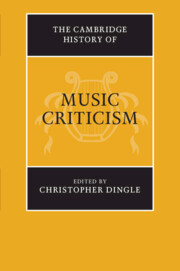Book contents
- The Cambridge History of Music Criticism
- The Cambridge History of Music
- The Cambridge History of Music Criticism
- Copyright page
- Contents
- Music Examples, Figures and Tables
- Notes on Contributors
- Acknowledgements
- Introduction
- Part I The Early History of Music Criticism
- 1 Speaking of Plainsong in the Middle Ages
- 2 Music Criticism in the Late-Medieval and Renaissance Era
- 3 Musical Discourse in Italy, 1500–1800
- 4 Music Criticism in France before the Revolution
- 5 Music Criticism in Britain up to Burney
- 6 German-Language Music Criticism before 1800
- Part II The Rise of the Press
- Part III Critical Influence and Influences
- Part IV Entering the Twentieth Century
- Part V New Areas
- Part VI Developments since the Second World War
- Postlude
- Bibliography
- Index
3 - Musical Discourse in Italy, 1500–1800
from Part I - The Early History of Music Criticism
Published online by Cambridge University Press: 21 August 2019
- The Cambridge History of Music Criticism
- The Cambridge History of Music
- The Cambridge History of Music Criticism
- Copyright page
- Contents
- Music Examples, Figures and Tables
- Notes on Contributors
- Acknowledgements
- Introduction
- Part I The Early History of Music Criticism
- 1 Speaking of Plainsong in the Middle Ages
- 2 Music Criticism in the Late-Medieval and Renaissance Era
- 3 Musical Discourse in Italy, 1500–1800
- 4 Music Criticism in France before the Revolution
- 5 Music Criticism in Britain up to Burney
- 6 German-Language Music Criticism before 1800
- Part II The Rise of the Press
- Part III Critical Influence and Influences
- Part IV Entering the Twentieth Century
- Part V New Areas
- Part VI Developments since the Second World War
- Postlude
- Bibliography
- Index
Summary
Music criticism, in the form we think of it today, did not exist for most of the period under discussion here; it was only in the final decades of the eighteenth century that concert reviews began to appear in the press, and even then they were not always unbiased critical appraisals. However, over the course of these three centuries musical discourse abounded in other forms – literary dialogues, travel journals, vehement polemics and personal letters – as musicians and music-lovers discussed what was a period of remarkable artistic fecundity via both printed and unpublished means. Through an overview of some of these discussions it is clear that, even over such a wide time period and geographical range, a number of clear trends emerge as to what was considered praiseworthy both in composition and performance. Prior to its unification in 1861 Italy constituted a varied group of smaller states, each with a distinctive musical tradition and outlook. Yet contemporary critical assessments of performances and music produced across the peninsular often highlight the same preoccupations: with the need for performers not to confuse mere technical display with musicality, and for composers to combine technical craft with a certain originality (although the extent to which critics allowed composers licence to break the rules in pursuit of innovation varied greatly, and led to some of the most heated debates of the period).
- Type
- Chapter
- Information
- The Cambridge History of Music Criticism , pp. 42 - 61Publisher: Cambridge University PressPrint publication year: 2019

